Art print | Destroys the tomb of the Port of the Cross - Hans Holbein the Elder


View from behind

Frame (optional)
The art print Destroying the Tomb of the Port of the Cross - Hans Holbein the Elder – Captivating introduction
In the fascinating universe of art, some works transcend time and space, captivating viewers with their depth and mystery. The art print Destroying the Tomb of the Port of the Cross - Hans Holbein the Elder is one of those iconic pieces that evoke a period of great artistic and cultural richness. This painting, although laden with complex symbolism, invites reflection on mortality, memory, and the quest for immortality through art. Immersing oneself in this work, the viewer is transported to a world where every detail, every color, and every form tells a story — that of a bygone era but still present in our minds.
Style and uniqueness of the work
The uniqueness of this piece lies in how Holbein the Elder manages to blend realism and symbolism. The human figures, with their startling accuracy, seem almost alive, as if they could step out of the frame at any moment. The treatment of shadows and lights gives an almost sculptural dimension to the characters, while the choice of colors evokes an atmosphere that is both solemn and melancholic. The architectural elements surrounding the scene, such as the tomb, are depicted with meticulous detail, emphasizing the importance of memory sites in the culture of the time. Holbein, with his distinctive style, succeeds in capturing the very essence of the human condition, oscillating between life and death, the tangible and the ephemeral.
The artist and his influence
Hans Holbein the Elder, an emblematic figure of the German Renaissance, established himself as a master in portrait art and narrative composition. His influence extends far beyond his era, inspiring many artists across the centuries. By exploring themes of death and memory, he paved the way for deeper reflection on the nature of human existence. Holbein was also a pioneer in the use of perspective and composition, techniques that were adopted and developed by his successors. His legacy is felt in European art, where the fusion of realism and symbolism continues

Matte finish

View from behind

Frame (optional)
The art print Destroying the Tomb of the Port of the Cross - Hans Holbein the Elder – Captivating introduction
In the fascinating universe of art, some works transcend time and space, captivating viewers with their depth and mystery. The art print Destroying the Tomb of the Port of the Cross - Hans Holbein the Elder is one of those iconic pieces that evoke a period of great artistic and cultural richness. This painting, although laden with complex symbolism, invites reflection on mortality, memory, and the quest for immortality through art. Immersing oneself in this work, the viewer is transported to a world where every detail, every color, and every form tells a story — that of a bygone era but still present in our minds.
Style and uniqueness of the work
The uniqueness of this piece lies in how Holbein the Elder manages to blend realism and symbolism. The human figures, with their startling accuracy, seem almost alive, as if they could step out of the frame at any moment. The treatment of shadows and lights gives an almost sculptural dimension to the characters, while the choice of colors evokes an atmosphere that is both solemn and melancholic. The architectural elements surrounding the scene, such as the tomb, are depicted with meticulous detail, emphasizing the importance of memory sites in the culture of the time. Holbein, with his distinctive style, succeeds in capturing the very essence of the human condition, oscillating between life and death, the tangible and the ephemeral.
The artist and his influence
Hans Holbein the Elder, an emblematic figure of the German Renaissance, established himself as a master in portrait art and narrative composition. His influence extends far beyond his era, inspiring many artists across the centuries. By exploring themes of death and memory, he paved the way for deeper reflection on the nature of human existence. Holbein was also a pioneer in the use of perspective and composition, techniques that were adopted and developed by his successors. His legacy is felt in European art, where the fusion of realism and symbolism continues










